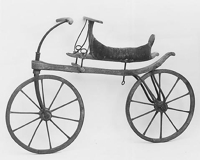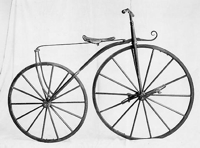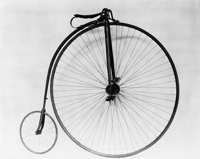

| Velocipedes | ||
|---|---|---|
Visit the Smithsonian Web page for this item to read the full description. |
To the left, this French "hobby-horse" vehicle is a predecessor to the bicycle. The rider would push his or her feet along the ground, usually in a running motion, to propel the vehicle. It was faster than walking, and coud even be as fast as a horse, but this was hard on feet and shoes. |
Visit the Smithsonian Web page for this item to read the full description.
|
This velocipede on the right is one of many models of an early bicycle with pedals. With its wooden wheels and no modern pneumatic tires, as we have today, velocipedes came to be known as "boneshakers." Is it any wonder the bicycle evolved further? |
||
High wheel "ordinary" bikes |
||
| The development of steel tension spokes allowed wheels of large diameter. The advantage of this, with pedals connected directly to the wheel's hub, was that each turn of the pedal meant more forward motion. This is similar to the advantage gained by different size sprockets in modern bikes. Developed in Europe, it was American Col. Albert Pope who mass produced the Ordinary, under the brand name Columbia, and made it affordable for many people. |
Visit the Smithsonian Web page for this item to read the full description. |
The ordinary was used in racing, because it could be fast. However, safety was a major concern with the high wheel ordinary bikes. The same big wheel that made it fast made it potentially dangerous. The rider sat far forward and very high, unable in almost every case to put his feet on the ground. Many accidents involved a rider flying forward in an abrupt stop from a fast forward speed. This caused broken collar bones and head injuries, among others. |
| Safety bicycles | ||
Visit the Smithsonian Web page for this item to read the full description. |
The "safety" bicycle design evolved in the late 1800's, largely from the safety concerns over ordinary bicycles. On a safety bicycle, the rider is far behind the front wheel, usually in the middle or toward the back of the bicycle. The bicycle has two equal or nearly equally sized wheels, and the pedals are connected to a sprocket below the saddle (seat). The pedal sprocket transfers power to a smaller diameter sprocket on the rear wheel hub by a chain. This design was pioneered by J. K. Starley and H. J. Lawson. While many incremental improvements have been made over the years, this basic form of bicycle has held for many years. In fact, it is the basic design for most modern bicycles. The bicycle pictured to the left is a woman's model, with a drop frame designed to accomodate women's long skirts. |
|
| Top | ||
Suggested Reading Books
Bicycle: The History, by David V. Herlihy. Yale University Press, 2004. ISBN
0300104189 Web Sites Dave's Vintage Bicycles |
||



